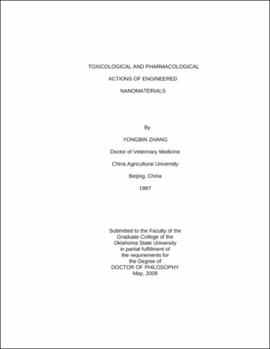| dc.contributor.advisor | Pope, Carey | |
| dc.contributor.author | Zhang, Yongbin | |
| dc.date.accessioned | 2013-11-26T08:35:18Z | |
| dc.date.available | 2013-11-26T08:35:18Z | |
| dc.date.issued | 2009-05 | |
| dc.identifier.uri | https://hdl.handle.net/11244/7680 | |
| dc.description.abstract | Scope and Method of Study: The toxicity of selected synthetic nanomaterials was studied using both in vitro and in vivo approaches. The toxicity of inorganic CdTe nanoparticles was first evaluated using both human HepG2 cells in vitro and systemic exposure in male rats in vivo. Cytotoxicity of organic fullerene aggregates was also evaluated in HepG2 cells. The potential utility of zinc oxide nanomaterials conjugated to a porphyrin derivative in the photodynamic therapy of ovarian cancer cells in vitro was evaluated. Mechanistic studies to determine the role of reactive oxygen species and oxidative stress in the cytotoxicity of all of these nanomaterials were conducted. A number of techniques/approaches including neurobehavioral assessments, biochemical assays, real-time PCR, western blotting, and both electron and confocal microscopy were used to address the biological consequences of nanomaterial exposure. | |
| dc.description.abstract | Findings and Conclusions: 1. CdTe nanoparticle-induced cytotoxicity is size- and concentration-dependent, involving caspase(s) activation, DNA fragmentation and metallothionein induction, but apparently not oxidative stress. 2. CdTe a;ltered motor activity following in vivo dosing, suggesting possible disruption of nervous system function, 3. Subcellar distribution of CdTe was size- and time- dependent. 4. Intact CdTe nanoparticles appeared to distribute into tissues following intravenous administration in rats. 5. Surface properties, size, chemical composition, and purity of nanomaterial preparations can all contribute to nanotoxicity. 6, Fullerene aggregates appeared to elicit cytotoxicity viz oxidative stress. 7. ZnO conjugates elicited selective photoxicity involving both apoptosis and necrosis, mediated by caspase(s0 activation and oxidative stress. | |
| dc.format | application/pdf | |
| dc.language | en_US | |
| dc.rights | Copyright is held by the author who has granted the Oklahoma State University Library the non-exclusive right to share this material in its institutional repository. Contact Digital Library Services at lib-dls@okstate.edu or 405-744-9161 for the permission policy on the use, reproduction or distribution of this material. | |
| dc.title | Toxicological and pharmacological actions of engineered nanomaterials | |
| dc.contributor.committeeMember | Breshears, Melanie | |
| dc.contributor.committeeMember | Chen, Guangping | |
| dc.contributor.committeeMember | Ausman, Kevin | |
| dc.contributor.committeeMember | Davis, Michael | |
| osu.filename | Zhang_okstate_0664D_10173.pdf | |
| osu.accesstype | Open Access | |
| dc.type.genre | Dissertation | |
| dc.type.material | Text | |
| thesis.degree.discipline | Veterinary Pathobiology | |
| thesis.degree.grantor | Oklahoma State University | |
